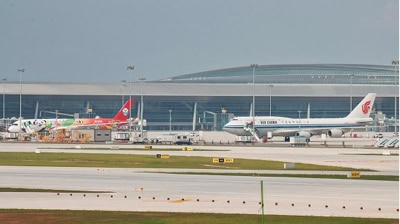Observer Report Beijing
China is accelerating the building of a modern air-port system that features a good layout and complete functions by transforming and expanding hub airports and building small and medium airports in remote areas.
During the first half of this year, fixed-asset invest-ment in China’s civil aviation industry amounted to 43.5 billion yuan ($6.72 billion), an increase of 8.5 percent year on year. By the end of June, 23 airports were under construction in the country.
Some newly-built airports made their maiden flights during the first six months of the year. On June 27, an aircraft of Sichuan Airlines left Chengdu Tianfu International Airport, a 4F-class airport situated in Chengdu city, southwest China’s Sichuan province, with 262 passengers. It was the first commercial flight of the airport after it was officially put into operation.
During the same period, the country also made pro-gress in the construction of some airports.
For ex-ample, Ezhou Huahu Airport, an airport under con-struction near Duwan village, Yanji township, Ezhou city, central China’s Hubei province, is changing with each passing day as over 6,000 con-structors work around the clock amid busy cranes and roaring concrete delivery trucks.
Ezhou Huahu Airport is the first professional cargo airport in Asia, said Zhang Gan, head of the plan-ning and development department of Hubei Interna-tional Logistics Airport Co., Ltd. After it is put into operation, the airport will achieve an annual cargo and mail throughput of more than two million tons, Zhang added.
Besides newly-built airports, airline hub transforma-tion and expansion projects also represented a large proportion of the investment in civil aviation indus-try from January to June.
According to Han Jun, an official with the Civil Aviation Administration of China, 40 of the 50 busiest airports i n China will undergo reconstruction and expansion.
Many airline hubs haven’t been able to satisfy the demands of rapidly growing air passenger traffic in recent years, which makes it necessary to increase their capacity and improve their comprehensive abilities and services, Han pointed out.
Another highlight of the investment in civil aviation during the first half of this year is the momentum of smart aviation.As smart aviation construction is continuously ad-vanced, air travelers’ experience has been signifi-cantly improved, Han said.
This year, 40 airline hubs in China will be covered by Radio Frequency Identification (RFID), an advanced technological means of luggage management in civil aviation industry, according to Han, who explained that if applied in whole-process luggage tracking system, RFID technology ensures faster and more accurate baggage claim than barcode recognition, not only saving passengers’ time, but allowing them to track luggage on their mobile phones.









